A friend of mine is a white-board kind of gal and she convinced me I needed one to organize my weekly schedule. Unfortunately, it sat in my office looking all blank and sad and dusty until last week, when I decided to “diagram” my Mise en Place project into stages for each of the eight garments.
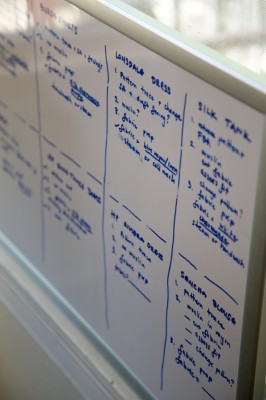
My first stage is done! This part was all about preliminary pattern work, like tracing, proofing the patterns, cutting them out. Any major adjustments, like design or fitting changes, will come later, at least with those I’m going to test out in a muslin. My workflow went a bit like this:
Tracing
I trace almost everything (unless it’s a one-size pattern, but even then I inevitably hack the pattern later and wish I had the original to compare).
Have you ever used transparent architect’s vellum paper (on the right in photo)? I love drawing on the stuff, but it’s amazing for traced patterns and is about the same weight and crispness as kraft paper. I have some cheap tissue paper for tracing but it’s so flimsy and vellum is stiffer. Granted, it’s more expensive and often quite narrow (like 18 to 30 inches wide) but I’ve managed to squeeze what I can.
I like some patterns–especially those I’ll use again–to be to be on even heavier paper. The manila/oak tag rolls used in pattern-making are the best. They are often sold in large expensive rolls but I’ve also seen this paper sold by the yard and in smaller rolls. Another less expensive option is 60# weight or heavier drawing paper by the roll, which most art stores carry, and I’ve been using to trace frequently used pieces like facings, belt loops, waistbands, etc.
Drafting any needed facings or extra pieces
Some patterns needed additional pieces. For example, this Burda piece from my shorts pattern is really two pieces in one–pocket and pocket facing, with 2 separate seamlines–and even though Burda says that I should cut four of these, I really need two of one and two of the other. So I traced and cut 2 separate patterns.
The Burda pattern also includes curved waistband pieces for front and back. Just in case, I want the option to have a slightly smaller inner waistband so that the seam rolls to the inside. (Kinda like the same idea as having a neckline facing that rolls to the inside.) So I traced off 1/16″ from the top and made separate inner patterns.
I think I’m going to have to draft some kind of facing for the Lonsdale dress. My riviera linen fabric is lovely but unfortunately feels a bit heavier than I’d hoped. The bodice of the Lonsdale is double-layered so I have to work out how to use one layer while keeping the inside neat.
Changing the seam allowances
About a year ago, I started trimming down seam allowances to 3/8″. This one pattern-tweaking task has really eased my sewing and I can’t recommend it enough. Sometimes I’ll even go down to 1/4″, depending on the seam. Unless I want a French seam, I’ve discovered that smaller seam allowances make for better sewing accuracy, and eliminate most of the need to grade, trim or clip seams after sewing (one of my least favorite tasks). I know some folks like to have the extra for fitting but I realized the 90% of the time my garments end up too big, not too small, so I gave up the idea I needed the extra fabric. I enjoy having all my paper and rulers out… and have gotten pretty fast at ruler-ing around patterns, adding or subtracting seam allowances.
Walking the patterns
I like walking patterns along the seamlines, which tells me 1. where I’m going to have to ease, if 2. the notches match, 3. if there are any patternmaking errors. If there are, at least I don’t pull my hair out thinking it’s my fault seams are weirdly un-matching.
Notching and hole-ing
In addition to good paper, these have to be my favorite patternmaking tools, a screw punch and a notcher:
Marking darts and buttonholes is so much easier if there’s already a hole in the pattern. Just lay the pattern on the fabric, stick a chalk pencil in the hole and you’re done. No need for tailor’s tacks or wax paper shenanigans. Well, I know some like doing it that way but I tried tailor’s tacks once and I went crazy. Slightly off the subject, but have you seen this tailoring video in which a pattern is marked entirely with thread? Old-world tailoring is romantic, but I find that thread-tracing seamlines takes five times as long as just having accurate, and small seam allowances–it’s nearly impossible to miss the seamline this way.
(I use the notcher because I chalk around my patterns, and need to chalk the notches, too. I have had such terrible cutting results, especially with knits, when cutting around the actual pattern.)
So that’s about it. I could probably sit waist deep in paper and tools forever; I just love imagining how flat shapes become 3-D, even dream about it sometimes. But it’s time to move along to testing stage; both my silk tank and the Sencha blouse need muslins (with the others I’m going to fit with the method called fingers-crossed-and-hope-it-works).
Would you like tips and inspiration in the craft of lingerie sewing? Sign up for my weekly eletter The Lingerie Maker.

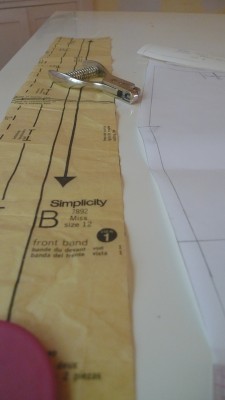
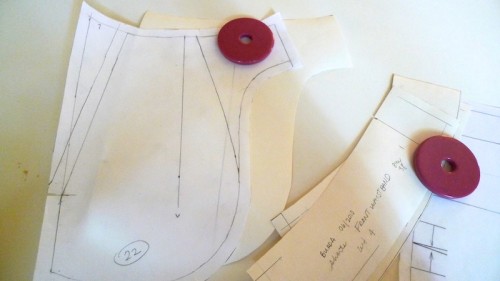

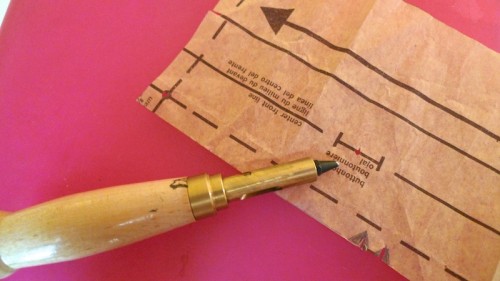
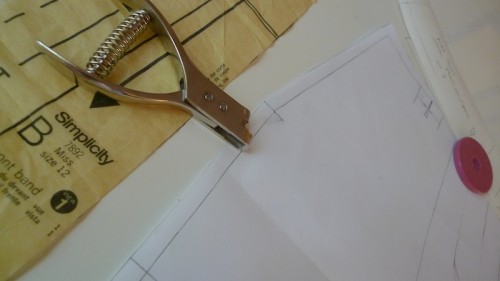
Oh, good for you! I am a tracer, too—occasionally I don’t, but I usually regret it. That vellum sounds especially interesting, I will have to try and hunt some down.
I think a facing would work for the Lonsdale as long as it included facing the ties completely… unless your fabric is too thick for that, too.
Good luck! 🙂
You’re right, I’ve been looking at the bodice piece, trying to figure out how to do a facing while keeping the ties and without interfering with the twist above the bust and it doesn’t look easy!